NSW Aboriginal Health Plan 2013-2023: Policy, Power, Politics
VerifiedAdded on 2021/05/27
|15
|4369
|53
Report
AI Summary
This report provides an in-depth analysis of the Aboriginal Health Plan 2013-2023, focusing on the healthcare provision for Aboriginal people in New South Wales. The paper examines the health disparities between Aboriginal and non-Aboriginal populations, highlighting factors such as poor healthcare facilities, illiteracy, and unemployment. It explores the NSW government's commitment to addressing these disparities through the ten-year plan developed in partnership with the Aboriginal Health and Medical Research Council of New South Wales. The analysis delves into the policy cycle, socio-economic determinants of health, and the intended outcomes of the plan, including reducing smoking rates, infant mortality, and preventable hospitalizations. The report also discusses the challenges in policy implementation, jurisdictional issues, and the need for community participation to improve Aboriginal health outcomes. The report further discusses the stated intention of the policy and its aims to promote a healthcare system.

Running head: POLICY, POWER AND POLITICS IN HEALTHCARE PROVISION
Policy, Power and Politics in Healthcare Provision
Name of the student:
Name of the university:
Author note
Policy, Power and Politics in Healthcare Provision
Name of the student:
Name of the university:
Author note
Paraphrase This Document
Need a fresh take? Get an instant paraphrase of this document with our AI Paraphraser
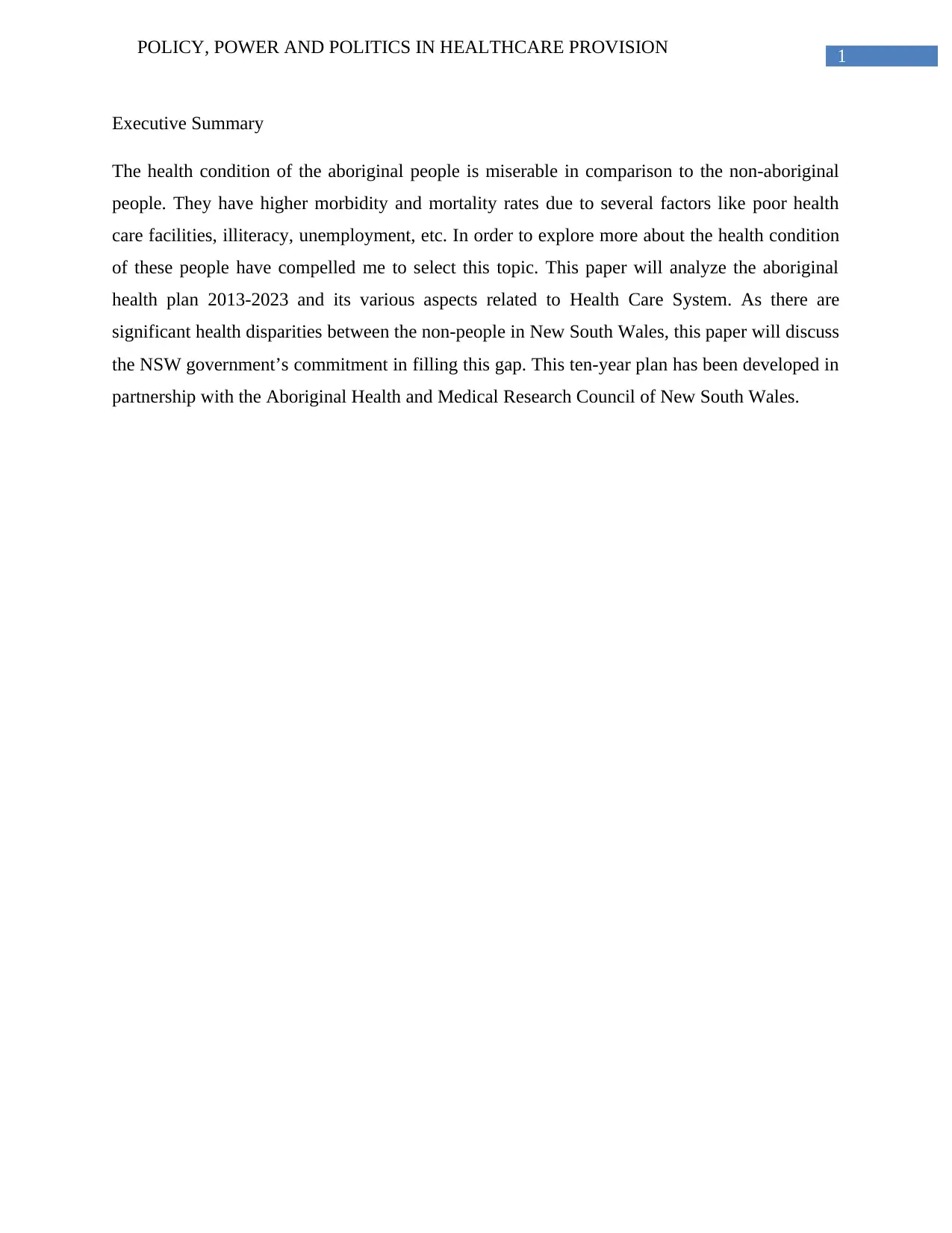
1POLICY, POWER AND POLITICS IN HEALTHCARE PROVISION
Executive Summary
The health condition of the aboriginal people is miserable in comparison to the non-aboriginal
people. They have higher morbidity and mortality rates due to several factors like poor health
care facilities, illiteracy, unemployment, etc. In order to explore more about the health condition
of these people have compelled me to select this topic. This paper will analyze the aboriginal
health plan 2013-2023 and its various aspects related to Health Care System. As there are
significant health disparities between the non-people in New South Wales, this paper will discuss
the NSW government’s commitment in filling this gap. This ten-year plan has been developed in
partnership with the Aboriginal Health and Medical Research Council of New South Wales.
Executive Summary
The health condition of the aboriginal people is miserable in comparison to the non-aboriginal
people. They have higher morbidity and mortality rates due to several factors like poor health
care facilities, illiteracy, unemployment, etc. In order to explore more about the health condition
of these people have compelled me to select this topic. This paper will analyze the aboriginal
health plan 2013-2023 and its various aspects related to Health Care System. As there are
significant health disparities between the non-people in New South Wales, this paper will discuss
the NSW government’s commitment in filling this gap. This ten-year plan has been developed in
partnership with the Aboriginal Health and Medical Research Council of New South Wales.

2POLICY, POWER AND POLITICS IN HEALTHCARE PROVISION
Contents
Introduction......................................................................................................................................3
Policy Analysis................................................................................................................................4
Understanding of policy issues....................................................................................................6
Evidence of critical discussion and analysis................................................................................7
Conclusion.....................................................................................................................................10
References......................................................................................................................................12
Contents
Introduction......................................................................................................................................3
Policy Analysis................................................................................................................................4
Understanding of policy issues....................................................................................................6
Evidence of critical discussion and analysis................................................................................7
Conclusion.....................................................................................................................................10
References......................................................................................................................................12
⊘ This is a preview!⊘
Do you want full access?
Subscribe today to unlock all pages.

Trusted by 1+ million students worldwide
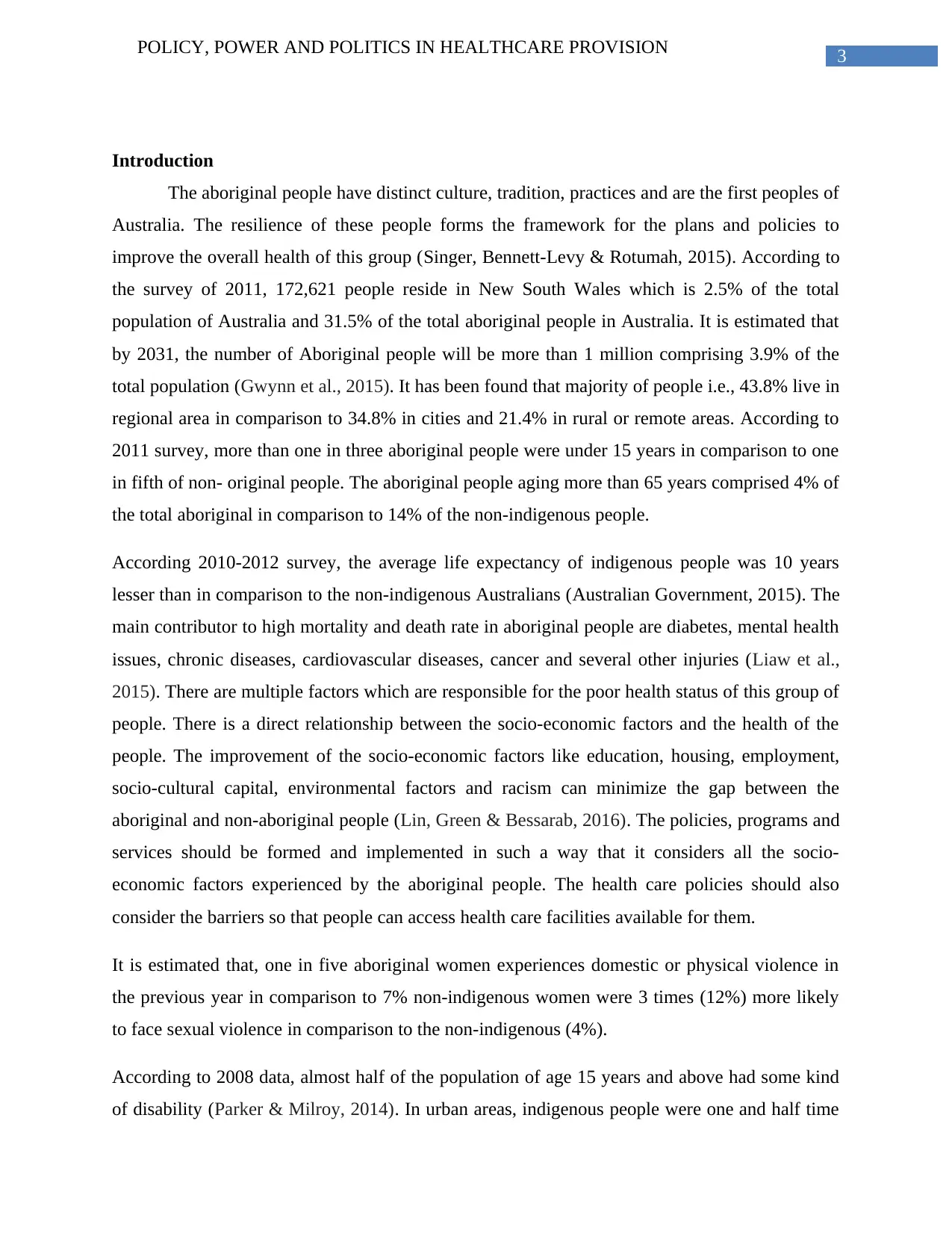
3POLICY, POWER AND POLITICS IN HEALTHCARE PROVISION
Introduction
The aboriginal people have distinct culture, tradition, practices and are the first peoples of
Australia. The resilience of these people forms the framework for the plans and policies to
improve the overall health of this group (Singer, Bennett-Levy & Rotumah, 2015). According to
the survey of 2011, 172,621 people reside in New South Wales which is 2.5% of the total
population of Australia and 31.5% of the total aboriginal people in Australia. It is estimated that
by 2031, the number of Aboriginal people will be more than 1 million comprising 3.9% of the
total population (Gwynn et al., 2015). It has been found that majority of people i.e., 43.8% live in
regional area in comparison to 34.8% in cities and 21.4% in rural or remote areas. According to
2011 survey, more than one in three aboriginal people were under 15 years in comparison to one
in fifth of non- original people. The aboriginal people aging more than 65 years comprised 4% of
the total aboriginal in comparison to 14% of the non-indigenous people.
According 2010-2012 survey, the average life expectancy of indigenous people was 10 years
lesser than in comparison to the non-indigenous Australians (Australian Government, 2015). The
main contributor to high mortality and death rate in aboriginal people are diabetes, mental health
issues, chronic diseases, cardiovascular diseases, cancer and several other injuries (Liaw et al.,
2015). There are multiple factors which are responsible for the poor health status of this group of
people. There is a direct relationship between the socio-economic factors and the health of the
people. The improvement of the socio-economic factors like education, housing, employment,
socio-cultural capital, environmental factors and racism can minimize the gap between the
aboriginal and non-aboriginal people (Lin, Green & Bessarab, 2016). The policies, programs and
services should be formed and implemented in such a way that it considers all the socio-
economic factors experienced by the aboriginal people. The health care policies should also
consider the barriers so that people can access health care facilities available for them.
It is estimated that, one in five aboriginal women experiences domestic or physical violence in
the previous year in comparison to 7% non-indigenous women were 3 times (12%) more likely
to face sexual violence in comparison to the non-indigenous (4%).
According to 2008 data, almost half of the population of age 15 years and above had some kind
of disability (Parker & Milroy, 2014). In urban areas, indigenous people were one and half time
Introduction
The aboriginal people have distinct culture, tradition, practices and are the first peoples of
Australia. The resilience of these people forms the framework for the plans and policies to
improve the overall health of this group (Singer, Bennett-Levy & Rotumah, 2015). According to
the survey of 2011, 172,621 people reside in New South Wales which is 2.5% of the total
population of Australia and 31.5% of the total aboriginal people in Australia. It is estimated that
by 2031, the number of Aboriginal people will be more than 1 million comprising 3.9% of the
total population (Gwynn et al., 2015). It has been found that majority of people i.e., 43.8% live in
regional area in comparison to 34.8% in cities and 21.4% in rural or remote areas. According to
2011 survey, more than one in three aboriginal people were under 15 years in comparison to one
in fifth of non- original people. The aboriginal people aging more than 65 years comprised 4% of
the total aboriginal in comparison to 14% of the non-indigenous people.
According 2010-2012 survey, the average life expectancy of indigenous people was 10 years
lesser than in comparison to the non-indigenous Australians (Australian Government, 2015). The
main contributor to high mortality and death rate in aboriginal people are diabetes, mental health
issues, chronic diseases, cardiovascular diseases, cancer and several other injuries (Liaw et al.,
2015). There are multiple factors which are responsible for the poor health status of this group of
people. There is a direct relationship between the socio-economic factors and the health of the
people. The improvement of the socio-economic factors like education, housing, employment,
socio-cultural capital, environmental factors and racism can minimize the gap between the
aboriginal and non-aboriginal people (Lin, Green & Bessarab, 2016). The policies, programs and
services should be formed and implemented in such a way that it considers all the socio-
economic factors experienced by the aboriginal people. The health care policies should also
consider the barriers so that people can access health care facilities available for them.
It is estimated that, one in five aboriginal women experiences domestic or physical violence in
the previous year in comparison to 7% non-indigenous women were 3 times (12%) more likely
to face sexual violence in comparison to the non-indigenous (4%).
According to 2008 data, almost half of the population of age 15 years and above had some kind
of disability (Parker & Milroy, 2014). In urban areas, indigenous people were one and half time
Paraphrase This Document
Need a fresh take? Get an instant paraphrase of this document with our AI Paraphraser
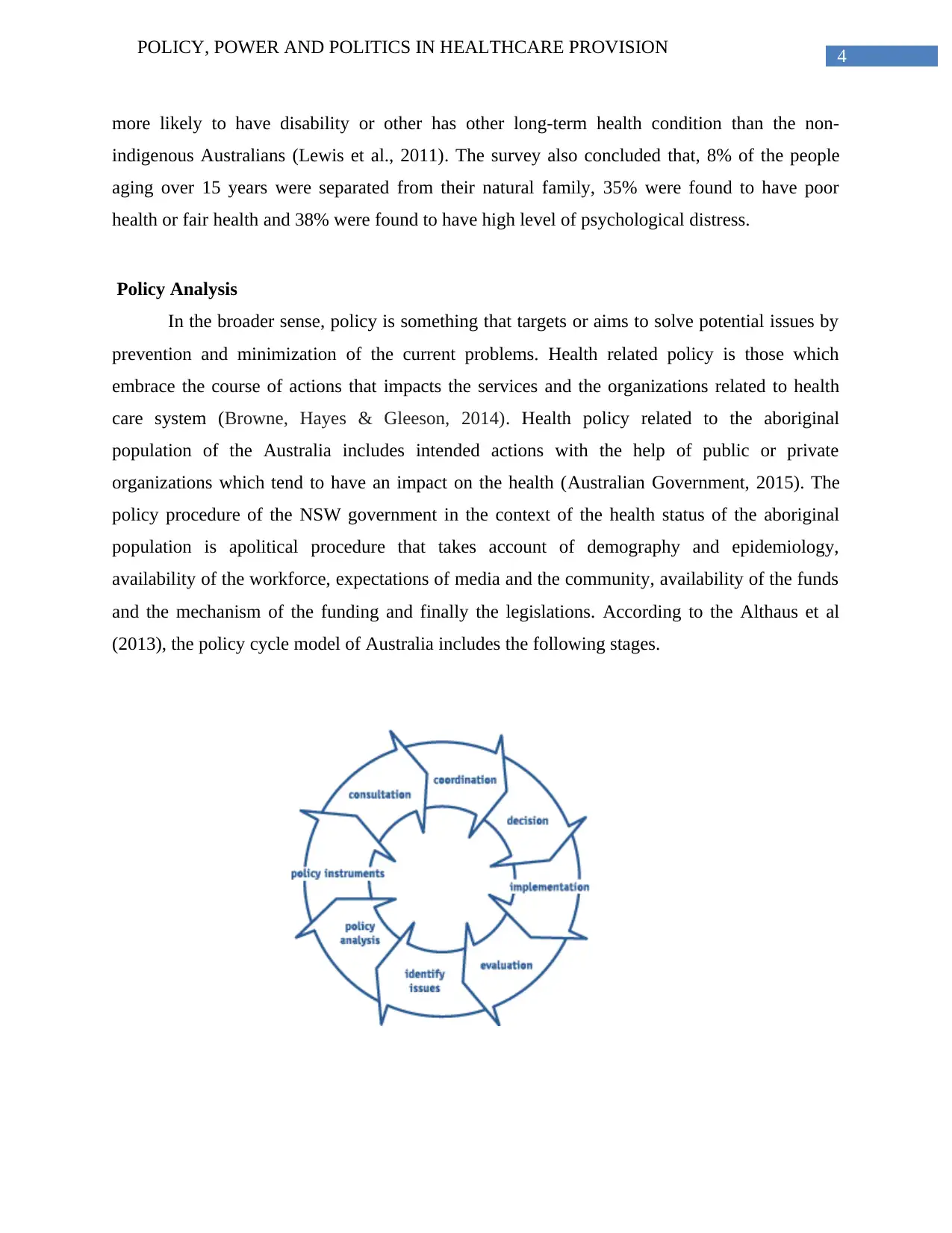
4POLICY, POWER AND POLITICS IN HEALTHCARE PROVISION
more likely to have disability or other has other long-term health condition than the non-
indigenous Australians (Lewis et al., 2011). The survey also concluded that, 8% of the people
aging over 15 years were separated from their natural family, 35% were found to have poor
health or fair health and 38% were found to have high level of psychological distress.
Policy Analysis
In the broader sense, policy is something that targets or aims to solve potential issues by
prevention and minimization of the current problems. Health related policy is those which
embrace the course of actions that impacts the services and the organizations related to health
care system (Browne, Hayes & Gleeson, 2014). Health policy related to the aboriginal
population of the Australia includes intended actions with the help of public or private
organizations which tend to have an impact on the health (Australian Government, 2015). The
policy procedure of the NSW government in the context of the health status of the aboriginal
population is apolitical procedure that takes account of demography and epidemiology,
availability of the workforce, expectations of media and the community, availability of the funds
and the mechanism of the funding and finally the legislations. According to the Althaus et al
(2013), the policy cycle model of Australia includes the following stages.
more likely to have disability or other has other long-term health condition than the non-
indigenous Australians (Lewis et al., 2011). The survey also concluded that, 8% of the people
aging over 15 years were separated from their natural family, 35% were found to have poor
health or fair health and 38% were found to have high level of psychological distress.
Policy Analysis
In the broader sense, policy is something that targets or aims to solve potential issues by
prevention and minimization of the current problems. Health related policy is those which
embrace the course of actions that impacts the services and the organizations related to health
care system (Browne, Hayes & Gleeson, 2014). Health policy related to the aboriginal
population of the Australia includes intended actions with the help of public or private
organizations which tend to have an impact on the health (Australian Government, 2015). The
policy procedure of the NSW government in the context of the health status of the aboriginal
population is apolitical procedure that takes account of demography and epidemiology,
availability of the workforce, expectations of media and the community, availability of the funds
and the mechanism of the funding and finally the legislations. According to the Althaus et al
(2013), the policy cycle model of Australia includes the following stages.
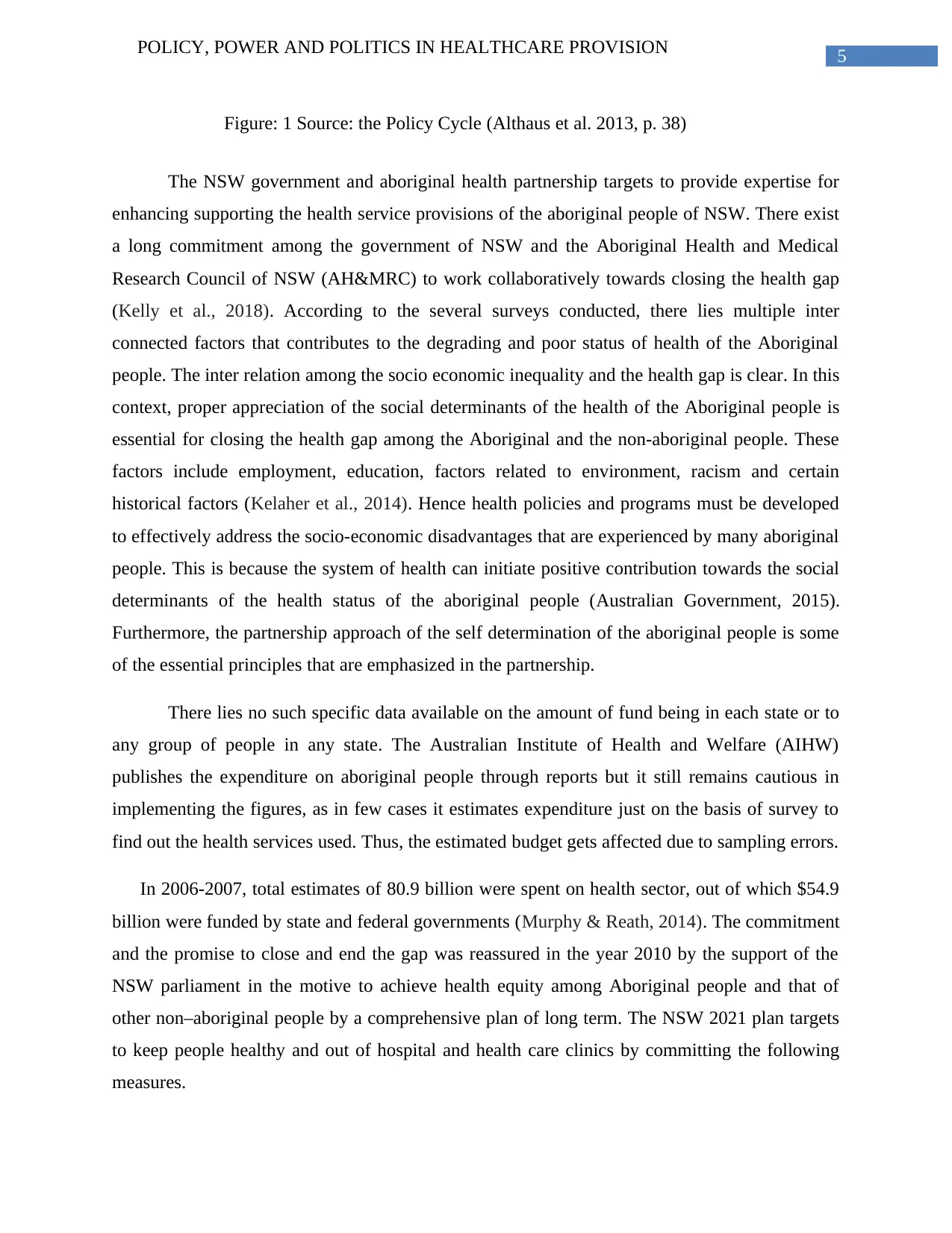
5POLICY, POWER AND POLITICS IN HEALTHCARE PROVISION
Figure: 1 Source: the Policy Cycle (Althaus et al. 2013, p. 38)
The NSW government and aboriginal health partnership targets to provide expertise for
enhancing supporting the health service provisions of the aboriginal people of NSW. There exist
a long commitment among the government of NSW and the Aboriginal Health and Medical
Research Council of NSW (AH&MRC) to work collaboratively towards closing the health gap
(Kelly et al., 2018). According to the several surveys conducted, there lies multiple inter
connected factors that contributes to the degrading and poor status of health of the Aboriginal
people. The inter relation among the socio economic inequality and the health gap is clear. In this
context, proper appreciation of the social determinants of the health of the Aboriginal people is
essential for closing the health gap among the Aboriginal and the non-aboriginal people. These
factors include employment, education, factors related to environment, racism and certain
historical factors (Kelaher et al., 2014). Hence health policies and programs must be developed
to effectively address the socio-economic disadvantages that are experienced by many aboriginal
people. This is because the system of health can initiate positive contribution towards the social
determinants of the health status of the aboriginal people (Australian Government, 2015).
Furthermore, the partnership approach of the self determination of the aboriginal people is some
of the essential principles that are emphasized in the partnership.
There lies no such specific data available on the amount of fund being in each state or to
any group of people in any state. The Australian Institute of Health and Welfare (AIHW)
publishes the expenditure on aboriginal people through reports but it still remains cautious in
implementing the figures, as in few cases it estimates expenditure just on the basis of survey to
find out the health services used. Thus, the estimated budget gets affected due to sampling errors.
In 2006-2007, total estimates of 80.9 billion were spent on health sector, out of which $54.9
billion were funded by state and federal governments (Murphy & Reath, 2014). The commitment
and the promise to close and end the gap was reassured in the year 2010 by the support of the
NSW parliament in the motive to achieve health equity among Aboriginal people and that of
other non–aboriginal people by a comprehensive plan of long term. The NSW 2021 plan targets
to keep people healthy and out of hospital and health care clinics by committing the following
measures.
Figure: 1 Source: the Policy Cycle (Althaus et al. 2013, p. 38)
The NSW government and aboriginal health partnership targets to provide expertise for
enhancing supporting the health service provisions of the aboriginal people of NSW. There exist
a long commitment among the government of NSW and the Aboriginal Health and Medical
Research Council of NSW (AH&MRC) to work collaboratively towards closing the health gap
(Kelly et al., 2018). According to the several surveys conducted, there lies multiple inter
connected factors that contributes to the degrading and poor status of health of the Aboriginal
people. The inter relation among the socio economic inequality and the health gap is clear. In this
context, proper appreciation of the social determinants of the health of the Aboriginal people is
essential for closing the health gap among the Aboriginal and the non-aboriginal people. These
factors include employment, education, factors related to environment, racism and certain
historical factors (Kelaher et al., 2014). Hence health policies and programs must be developed
to effectively address the socio-economic disadvantages that are experienced by many aboriginal
people. This is because the system of health can initiate positive contribution towards the social
determinants of the health status of the aboriginal people (Australian Government, 2015).
Furthermore, the partnership approach of the self determination of the aboriginal people is some
of the essential principles that are emphasized in the partnership.
There lies no such specific data available on the amount of fund being in each state or to
any group of people in any state. The Australian Institute of Health and Welfare (AIHW)
publishes the expenditure on aboriginal people through reports but it still remains cautious in
implementing the figures, as in few cases it estimates expenditure just on the basis of survey to
find out the health services used. Thus, the estimated budget gets affected due to sampling errors.
In 2006-2007, total estimates of 80.9 billion were spent on health sector, out of which $54.9
billion were funded by state and federal governments (Murphy & Reath, 2014). The commitment
and the promise to close and end the gap was reassured in the year 2010 by the support of the
NSW parliament in the motive to achieve health equity among Aboriginal people and that of
other non–aboriginal people by a comprehensive plan of long term. The NSW 2021 plan targets
to keep people healthy and out of hospital and health care clinics by committing the following
measures.
⊘ This is a preview!⊘
Do you want full access?
Subscribe today to unlock all pages.

Trusted by 1+ million students worldwide
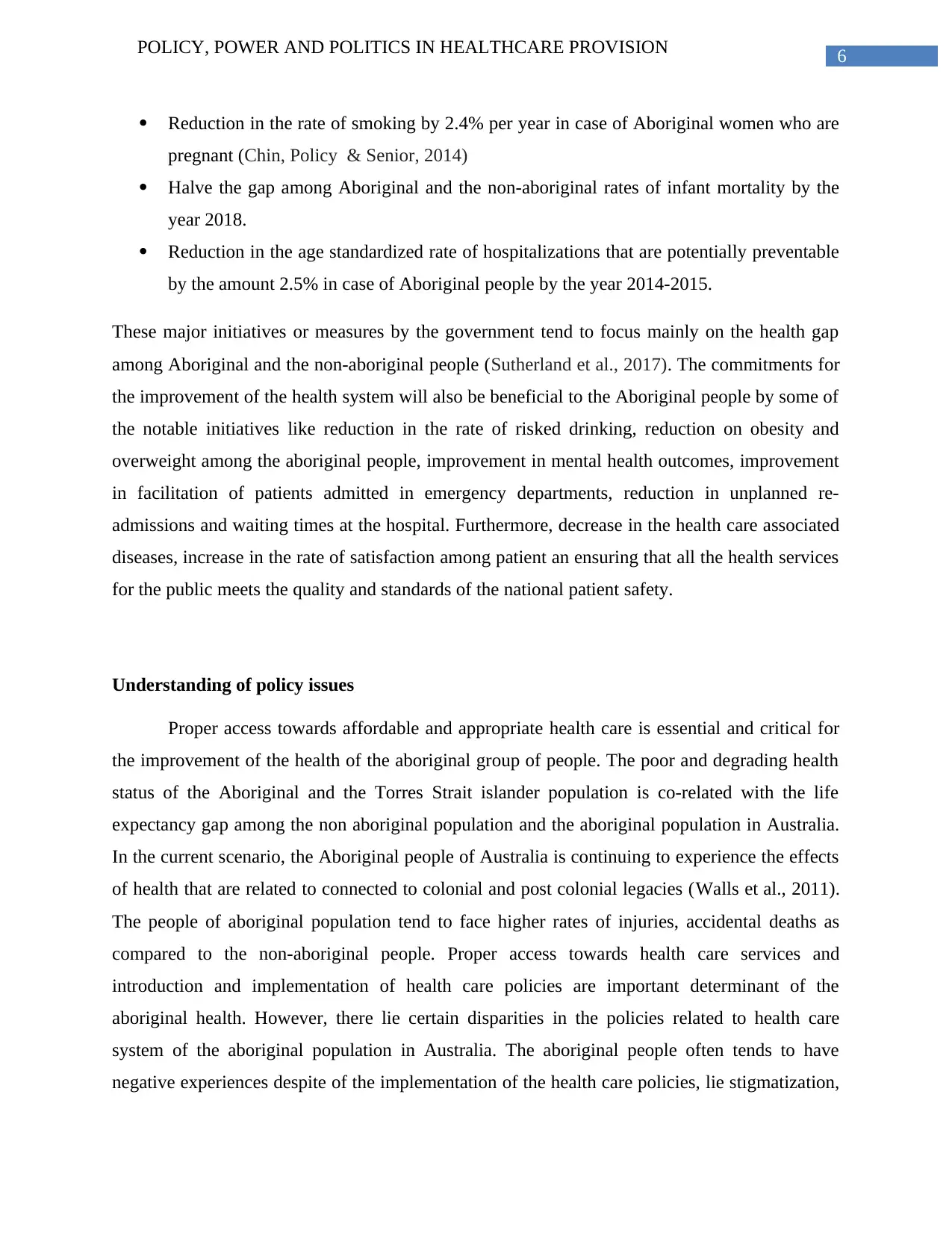
6POLICY, POWER AND POLITICS IN HEALTHCARE PROVISION
Reduction in the rate of smoking by 2.4% per year in case of Aboriginal women who are
pregnant (Chin, Policy & Senior, 2014)
Halve the gap among Aboriginal and the non-aboriginal rates of infant mortality by the
year 2018.
Reduction in the age standardized rate of hospitalizations that are potentially preventable
by the amount 2.5% in case of Aboriginal people by the year 2014-2015.
These major initiatives or measures by the government tend to focus mainly on the health gap
among Aboriginal and the non-aboriginal people (Sutherland et al., 2017). The commitments for
the improvement of the health system will also be beneficial to the Aboriginal people by some of
the notable initiatives like reduction in the rate of risked drinking, reduction on obesity and
overweight among the aboriginal people, improvement in mental health outcomes, improvement
in facilitation of patients admitted in emergency departments, reduction in unplanned re-
admissions and waiting times at the hospital. Furthermore, decrease in the health care associated
diseases, increase in the rate of satisfaction among patient an ensuring that all the health services
for the public meets the quality and standards of the national patient safety.
Understanding of policy issues
Proper access towards affordable and appropriate health care is essential and critical for
the improvement of the health of the aboriginal group of people. The poor and degrading health
status of the Aboriginal and the Torres Strait islander population is co-related with the life
expectancy gap among the non aboriginal population and the aboriginal population in Australia.
In the current scenario, the Aboriginal people of Australia is continuing to experience the effects
of health that are related to connected to colonial and post colonial legacies (Walls et al., 2011).
The people of aboriginal population tend to face higher rates of injuries, accidental deaths as
compared to the non-aboriginal people. Proper access towards health care services and
introduction and implementation of health care policies are important determinant of the
aboriginal health. However, there lie certain disparities in the policies related to health care
system of the aboriginal population in Australia. The aboriginal people often tends to have
negative experiences despite of the implementation of the health care policies, lie stigmatization,
Reduction in the rate of smoking by 2.4% per year in case of Aboriginal women who are
pregnant (Chin, Policy & Senior, 2014)
Halve the gap among Aboriginal and the non-aboriginal rates of infant mortality by the
year 2018.
Reduction in the age standardized rate of hospitalizations that are potentially preventable
by the amount 2.5% in case of Aboriginal people by the year 2014-2015.
These major initiatives or measures by the government tend to focus mainly on the health gap
among Aboriginal and the non-aboriginal people (Sutherland et al., 2017). The commitments for
the improvement of the health system will also be beneficial to the Aboriginal people by some of
the notable initiatives like reduction in the rate of risked drinking, reduction on obesity and
overweight among the aboriginal people, improvement in mental health outcomes, improvement
in facilitation of patients admitted in emergency departments, reduction in unplanned re-
admissions and waiting times at the hospital. Furthermore, decrease in the health care associated
diseases, increase in the rate of satisfaction among patient an ensuring that all the health services
for the public meets the quality and standards of the national patient safety.
Understanding of policy issues
Proper access towards affordable and appropriate health care is essential and critical for
the improvement of the health of the aboriginal group of people. The poor and degrading health
status of the Aboriginal and the Torres Strait islander population is co-related with the life
expectancy gap among the non aboriginal population and the aboriginal population in Australia.
In the current scenario, the Aboriginal people of Australia is continuing to experience the effects
of health that are related to connected to colonial and post colonial legacies (Walls et al., 2011).
The people of aboriginal population tend to face higher rates of injuries, accidental deaths as
compared to the non-aboriginal people. Proper access towards health care services and
introduction and implementation of health care policies are important determinant of the
aboriginal health. However, there lie certain disparities in the policies related to health care
system of the aboriginal population in Australia. The aboriginal people often tends to have
negative experiences despite of the implementation of the health care policies, lie stigmatization,
Paraphrase This Document
Need a fresh take? Get an instant paraphrase of this document with our AI Paraphraser

7POLICY, POWER AND POLITICS IN HEALTHCARE PROVISION
discrimination, marginalization, persistence of colonial attitudes and beliefs within the nation
and the society (Singer, Bennett-Levy & Rotumah, 2015). While many of the policies related to
health care system has been developed for the aboriginal population and the policies may have
initiated major improvements towards access to health care services and empowerment of the
aboriginal community, the policy come with administrative and bureaucratic challenges that
operates at the community level. These are some one of the major issues of the Aboriginal
Health plan 2013-2023 (Lia et al., 2016). Furthermore researches revealed the weakness of the
measures of the policy that limits the space for the communities of aboriginal people for
undertaking political captivity. There has been considerably low number of researches on the
field on how the health care policies are implemented and whether the effectiveness of the
policies reaches the aboriginal people.
There lie several measure and mechanisms that have originated to bridge the jurisdiction
gaps and to propagate the participation of the aboriginal people towards identification of
priorities related to health and co-ordination of approaches for the improvement of aboriginal
health (Liaw et al., 2015). The most notable approaches by the NSW government are the
intergovernmental health authorities and the cross jurisdictional mechanisms in the context of
Aboriginal Health plan 2013-2023 (Australian Government, 2015). But both of these policies
and approaches targets the needs and the requirements of the population of the first nations and
not the aboriginal group residing within those provinces. Northern Health Strategy of 2008,
Assembly of Manitoba Chiefs of 2010, Athabasca Health Authority of 1995 are some of the
examples of approaches by the aboriginal health authorities which lacks proper implementation
and monitoring of the health status of the aboriginal group (Althaus, Bridgman & Davis, 2013).
The health policies of the aboriginal population are often hampered by the legislative confusion
and hence addresses towards jurisdictional disputes are necessary for the improvement of the
indigenous health policy implementation.
Evidence of critical discussion and analysis
1. What is the stated intention of the policy?
discrimination, marginalization, persistence of colonial attitudes and beliefs within the nation
and the society (Singer, Bennett-Levy & Rotumah, 2015). While many of the policies related to
health care system has been developed for the aboriginal population and the policies may have
initiated major improvements towards access to health care services and empowerment of the
aboriginal community, the policy come with administrative and bureaucratic challenges that
operates at the community level. These are some one of the major issues of the Aboriginal
Health plan 2013-2023 (Lia et al., 2016). Furthermore researches revealed the weakness of the
measures of the policy that limits the space for the communities of aboriginal people for
undertaking political captivity. There has been considerably low number of researches on the
field on how the health care policies are implemented and whether the effectiveness of the
policies reaches the aboriginal people.
There lie several measure and mechanisms that have originated to bridge the jurisdiction
gaps and to propagate the participation of the aboriginal people towards identification of
priorities related to health and co-ordination of approaches for the improvement of aboriginal
health (Liaw et al., 2015). The most notable approaches by the NSW government are the
intergovernmental health authorities and the cross jurisdictional mechanisms in the context of
Aboriginal Health plan 2013-2023 (Australian Government, 2015). But both of these policies
and approaches targets the needs and the requirements of the population of the first nations and
not the aboriginal group residing within those provinces. Northern Health Strategy of 2008,
Assembly of Manitoba Chiefs of 2010, Athabasca Health Authority of 1995 are some of the
examples of approaches by the aboriginal health authorities which lacks proper implementation
and monitoring of the health status of the aboriginal group (Althaus, Bridgman & Davis, 2013).
The health policies of the aboriginal population are often hampered by the legislative confusion
and hence addresses towards jurisdictional disputes are necessary for the improvement of the
indigenous health policy implementation.
Evidence of critical discussion and analysis
1. What is the stated intention of the policy?
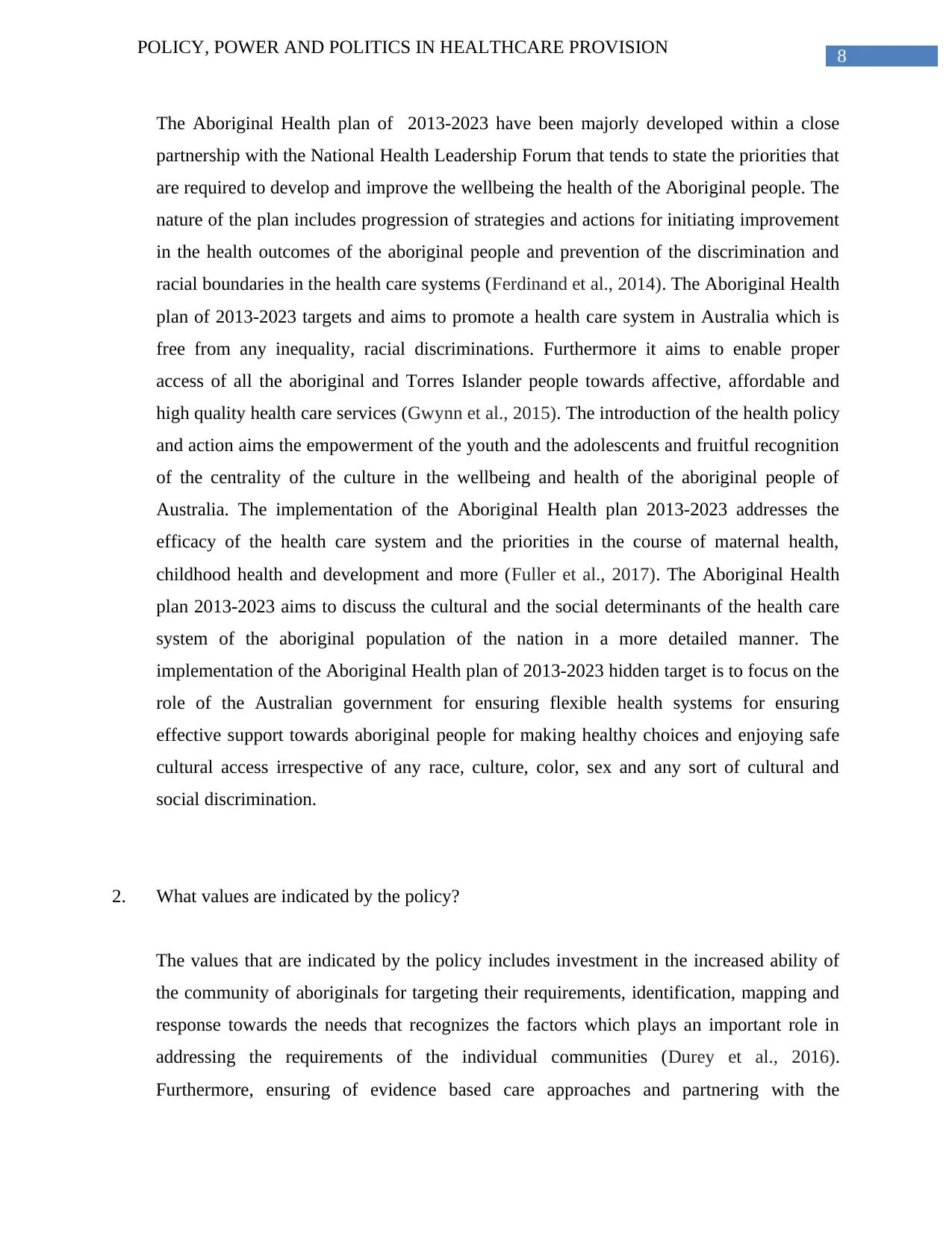
8POLICY, POWER AND POLITICS IN HEALTHCARE PROVISION
The Aboriginal Health plan of 2013-2023 have been majorly developed within a close
partnership with the National Health Leadership Forum that tends to state the priorities that
are required to develop and improve the wellbeing the health of the Aboriginal people. The
nature of the plan includes progression of strategies and actions for initiating improvement
in the health outcomes of the aboriginal people and prevention of the discrimination and
racial boundaries in the health care systems (Ferdinand et al., 2014). The Aboriginal Health
plan of 2013-2023 targets and aims to promote a health care system in Australia which is
free from any inequality, racial discriminations. Furthermore it aims to enable proper
access of all the aboriginal and Torres Islander people towards affective, affordable and
high quality health care services (Gwynn et al., 2015). The introduction of the health policy
and action aims the empowerment of the youth and the adolescents and fruitful recognition
of the centrality of the culture in the wellbeing and health of the aboriginal people of
Australia. The implementation of the Aboriginal Health plan 2013-2023 addresses the
efficacy of the health care system and the priorities in the course of maternal health,
childhood health and development and more (Fuller et al., 2017). The Aboriginal Health
plan 2013-2023 aims to discuss the cultural and the social determinants of the health care
system of the aboriginal population of the nation in a more detailed manner. The
implementation of the Aboriginal Health plan of 2013-2023 hidden target is to focus on the
role of the Australian government for ensuring flexible health systems for ensuring
effective support towards aboriginal people for making healthy choices and enjoying safe
cultural access irrespective of any race, culture, color, sex and any sort of cultural and
social discrimination.
2. What values are indicated by the policy?
The values that are indicated by the policy includes investment in the increased ability of
the community of aboriginals for targeting their requirements, identification, mapping and
response towards the needs that recognizes the factors which plays an important role in
addressing the requirements of the individual communities (Durey et al., 2016).
Furthermore, ensuring of evidence based care approaches and partnering with the
The Aboriginal Health plan of 2013-2023 have been majorly developed within a close
partnership with the National Health Leadership Forum that tends to state the priorities that
are required to develop and improve the wellbeing the health of the Aboriginal people. The
nature of the plan includes progression of strategies and actions for initiating improvement
in the health outcomes of the aboriginal people and prevention of the discrimination and
racial boundaries in the health care systems (Ferdinand et al., 2014). The Aboriginal Health
plan of 2013-2023 targets and aims to promote a health care system in Australia which is
free from any inequality, racial discriminations. Furthermore it aims to enable proper
access of all the aboriginal and Torres Islander people towards affective, affordable and
high quality health care services (Gwynn et al., 2015). The introduction of the health policy
and action aims the empowerment of the youth and the adolescents and fruitful recognition
of the centrality of the culture in the wellbeing and health of the aboriginal people of
Australia. The implementation of the Aboriginal Health plan 2013-2023 addresses the
efficacy of the health care system and the priorities in the course of maternal health,
childhood health and development and more (Fuller et al., 2017). The Aboriginal Health
plan 2013-2023 aims to discuss the cultural and the social determinants of the health care
system of the aboriginal population of the nation in a more detailed manner. The
implementation of the Aboriginal Health plan of 2013-2023 hidden target is to focus on the
role of the Australian government for ensuring flexible health systems for ensuring
effective support towards aboriginal people for making healthy choices and enjoying safe
cultural access irrespective of any race, culture, color, sex and any sort of cultural and
social discrimination.
2. What values are indicated by the policy?
The values that are indicated by the policy includes investment in the increased ability of
the community of aboriginals for targeting their requirements, identification, mapping and
response towards the needs that recognizes the factors which plays an important role in
addressing the requirements of the individual communities (Durey et al., 2016).
Furthermore, ensuring of evidence based care approaches and partnering with the
⊘ This is a preview!⊘
Do you want full access?
Subscribe today to unlock all pages.

Trusted by 1+ million students worldwide
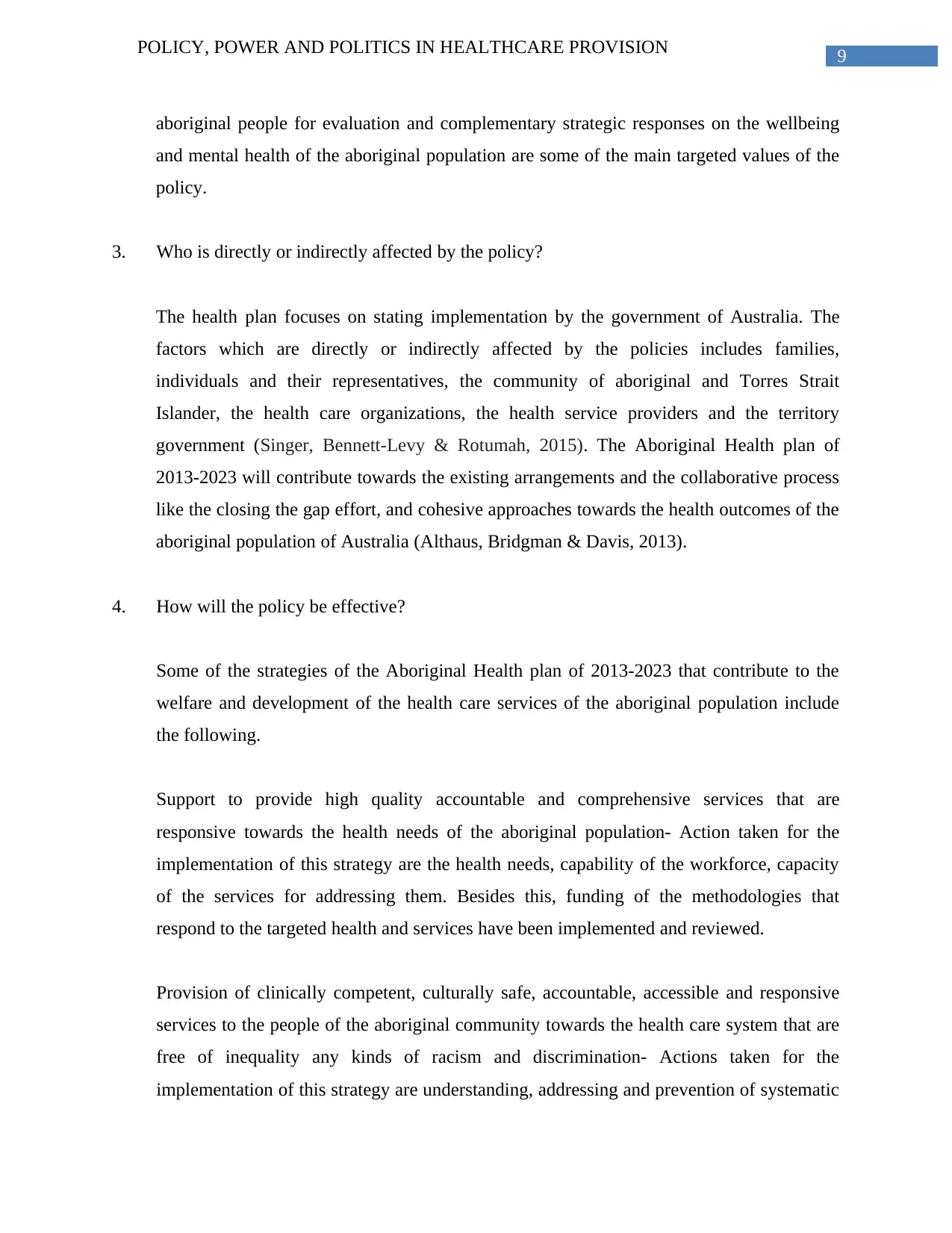
9POLICY, POWER AND POLITICS IN HEALTHCARE PROVISION
aboriginal people for evaluation and complementary strategic responses on the wellbeing
and mental health of the aboriginal population are some of the main targeted values of the
policy.
3. Who is directly or indirectly affected by the policy?
The health plan focuses on stating implementation by the government of Australia. The
factors which are directly or indirectly affected by the policies includes families,
individuals and their representatives, the community of aboriginal and Torres Strait
Islander, the health care organizations, the health service providers and the territory
government (Singer, Bennett-Levy & Rotumah, 2015). The Aboriginal Health plan of
2013-2023 will contribute towards the existing arrangements and the collaborative process
like the closing the gap effort, and cohesive approaches towards the health outcomes of the
aboriginal population of Australia (Althaus, Bridgman & Davis, 2013).
4. How will the policy be effective?
Some of the strategies of the Aboriginal Health plan of 2013-2023 that contribute to the
welfare and development of the health care services of the aboriginal population include
the following.
Support to provide high quality accountable and comprehensive services that are
responsive towards the health needs of the aboriginal population- Action taken for the
implementation of this strategy are the health needs, capability of the workforce, capacity
of the services for addressing them. Besides this, funding of the methodologies that
respond to the targeted health and services have been implemented and reviewed.
Provision of clinically competent, culturally safe, accountable, accessible and responsive
services to the people of the aboriginal community towards the health care system that are
free of inequality any kinds of racism and discrimination- Actions taken for the
implementation of this strategy are understanding, addressing and prevention of systematic
aboriginal people for evaluation and complementary strategic responses on the wellbeing
and mental health of the aboriginal population are some of the main targeted values of the
policy.
3. Who is directly or indirectly affected by the policy?
The health plan focuses on stating implementation by the government of Australia. The
factors which are directly or indirectly affected by the policies includes families,
individuals and their representatives, the community of aboriginal and Torres Strait
Islander, the health care organizations, the health service providers and the territory
government (Singer, Bennett-Levy & Rotumah, 2015). The Aboriginal Health plan of
2013-2023 will contribute towards the existing arrangements and the collaborative process
like the closing the gap effort, and cohesive approaches towards the health outcomes of the
aboriginal population of Australia (Althaus, Bridgman & Davis, 2013).
4. How will the policy be effective?
Some of the strategies of the Aboriginal Health plan of 2013-2023 that contribute to the
welfare and development of the health care services of the aboriginal population include
the following.
Support to provide high quality accountable and comprehensive services that are
responsive towards the health needs of the aboriginal population- Action taken for the
implementation of this strategy are the health needs, capability of the workforce, capacity
of the services for addressing them. Besides this, funding of the methodologies that
respond to the targeted health and services have been implemented and reviewed.
Provision of clinically competent, culturally safe, accountable, accessible and responsive
services to the people of the aboriginal community towards the health care system that are
free of inequality any kinds of racism and discrimination- Actions taken for the
implementation of this strategy are understanding, addressing and prevention of systematic
Paraphrase This Document
Need a fresh take? Get an instant paraphrase of this document with our AI Paraphraser

10POLICY, POWER AND POLITICS IN HEALTHCARE PROVISION
racism and discrimination. Inclusive and accessible health services to disabled people,
guidance on equitable access to specialist medical care are some of the actions for the
targeted strategy.
5. What processes are in place to evaluate the policy’s effectiveness?
According to the government of Australia, no strategies and plan regarding the health care
system of aboriginal people can be successful without a robust partnership among the
government and the aboriginal population of Australia. Hence the plan is not at all
politically neutral since the aim of the Aboriginal Health plan of 2013-2023 targets the
social determinants of health and the context of racism. It is thus not possible to be
politically neutral. While evaluating the policy, the interest of the aboriginal and the Torres
Strait islander people are being taken into account (Lin, Green & Bessarab, 2016). The
implementation of the policy targets the successful development of the set of measurable
targets over the next 10-12 years, the development and implementation of the national
workforce strategy targeting the health care needs and priorities of the aboriginal group of
people as compared to the other population and communities of the nation (Althaus,
Bridgman & Davis, 2013). The policy aims to achieve its targets regarding the wellness
and the welfare of the health status of the aboriginal group of people in the long run. The
five main programs of the Aboriginal Health plan of 2013-2023 include Children and
Schooling, the Culture and Capability, Jobs, Land and Economy, the Safety and Wellbeing
and the Remote Australia Strategies.
Conclusion
The central features of the Aboriginal Health plan of 2013-2023 are addressing the social
determinants of health and addressing the essentiality of tacking discrimination in the context of
race. The strategies of the plan initiates a strength based approach which focuses on the social
and emotional wellbeing, health and centrality of the culture in the context of health care of the
aboriginal group of people. In the target to close the gap of health, the government of Australia
racism and discrimination. Inclusive and accessible health services to disabled people,
guidance on equitable access to specialist medical care are some of the actions for the
targeted strategy.
5. What processes are in place to evaluate the policy’s effectiveness?
According to the government of Australia, no strategies and plan regarding the health care
system of aboriginal people can be successful without a robust partnership among the
government and the aboriginal population of Australia. Hence the plan is not at all
politically neutral since the aim of the Aboriginal Health plan of 2013-2023 targets the
social determinants of health and the context of racism. It is thus not possible to be
politically neutral. While evaluating the policy, the interest of the aboriginal and the Torres
Strait islander people are being taken into account (Lin, Green & Bessarab, 2016). The
implementation of the policy targets the successful development of the set of measurable
targets over the next 10-12 years, the development and implementation of the national
workforce strategy targeting the health care needs and priorities of the aboriginal group of
people as compared to the other population and communities of the nation (Althaus,
Bridgman & Davis, 2013). The policy aims to achieve its targets regarding the wellness
and the welfare of the health status of the aboriginal group of people in the long run. The
five main programs of the Aboriginal Health plan of 2013-2023 include Children and
Schooling, the Culture and Capability, Jobs, Land and Economy, the Safety and Wellbeing
and the Remote Australia Strategies.
Conclusion
The central features of the Aboriginal Health plan of 2013-2023 are addressing the social
determinants of health and addressing the essentiality of tacking discrimination in the context of
race. The strategies of the plan initiates a strength based approach which focuses on the social
and emotional wellbeing, health and centrality of the culture in the context of health care of the
aboriginal group of people. In the target to close the gap of health, the government of Australia
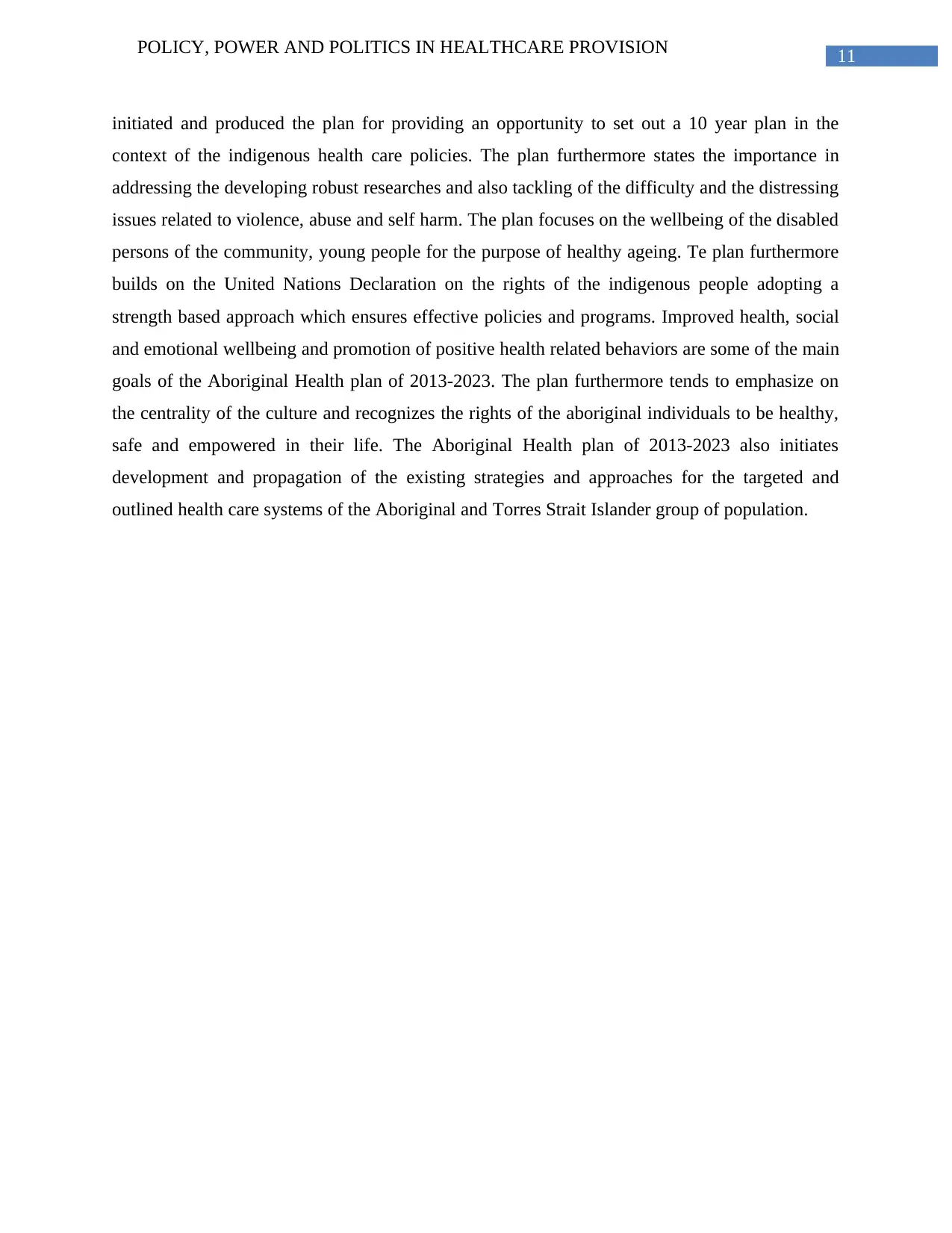
11POLICY, POWER AND POLITICS IN HEALTHCARE PROVISION
initiated and produced the plan for providing an opportunity to set out a 10 year plan in the
context of the indigenous health care policies. The plan furthermore states the importance in
addressing the developing robust researches and also tackling of the difficulty and the distressing
issues related to violence, abuse and self harm. The plan focuses on the wellbeing of the disabled
persons of the community, young people for the purpose of healthy ageing. Te plan furthermore
builds on the United Nations Declaration on the rights of the indigenous people adopting a
strength based approach which ensures effective policies and programs. Improved health, social
and emotional wellbeing and promotion of positive health related behaviors are some of the main
goals of the Aboriginal Health plan of 2013-2023. The plan furthermore tends to emphasize on
the centrality of the culture and recognizes the rights of the aboriginal individuals to be healthy,
safe and empowered in their life. The Aboriginal Health plan of 2013-2023 also initiates
development and propagation of the existing strategies and approaches for the targeted and
outlined health care systems of the Aboriginal and Torres Strait Islander group of population.
initiated and produced the plan for providing an opportunity to set out a 10 year plan in the
context of the indigenous health care policies. The plan furthermore states the importance in
addressing the developing robust researches and also tackling of the difficulty and the distressing
issues related to violence, abuse and self harm. The plan focuses on the wellbeing of the disabled
persons of the community, young people for the purpose of healthy ageing. Te plan furthermore
builds on the United Nations Declaration on the rights of the indigenous people adopting a
strength based approach which ensures effective policies and programs. Improved health, social
and emotional wellbeing and promotion of positive health related behaviors are some of the main
goals of the Aboriginal Health plan of 2013-2023. The plan furthermore tends to emphasize on
the centrality of the culture and recognizes the rights of the aboriginal individuals to be healthy,
safe and empowered in their life. The Aboriginal Health plan of 2013-2023 also initiates
development and propagation of the existing strategies and approaches for the targeted and
outlined health care systems of the Aboriginal and Torres Strait Islander group of population.
⊘ This is a preview!⊘
Do you want full access?
Subscribe today to unlock all pages.

Trusted by 1+ million students worldwide
1 out of 15
Related Documents
Your All-in-One AI-Powered Toolkit for Academic Success.
+13062052269
info@desklib.com
Available 24*7 on WhatsApp / Email
![[object Object]](/_next/static/media/star-bottom.7253800d.svg)
Unlock your academic potential
Copyright © 2020–2025 A2Z Services. All Rights Reserved. Developed and managed by ZUCOL.





